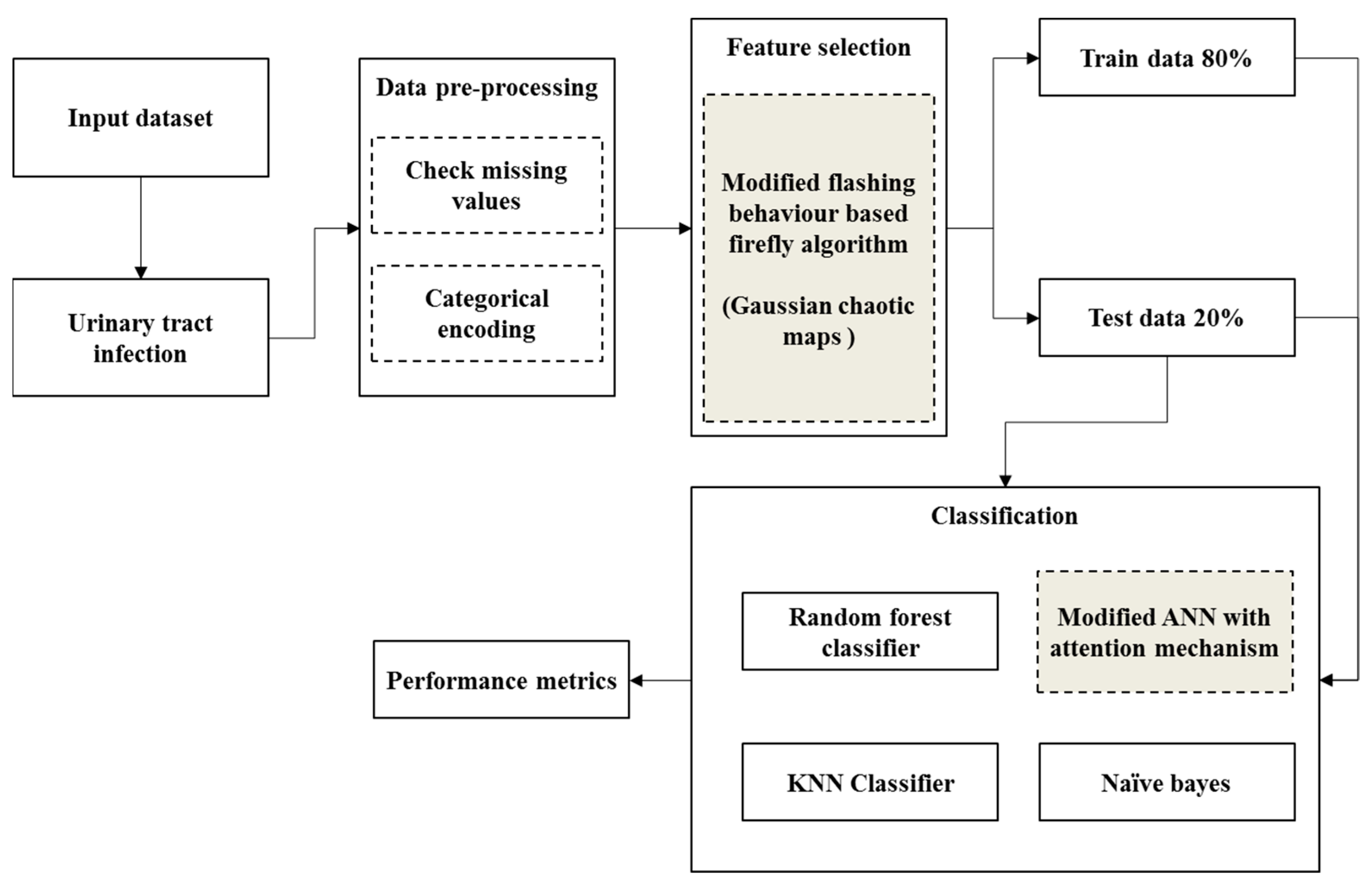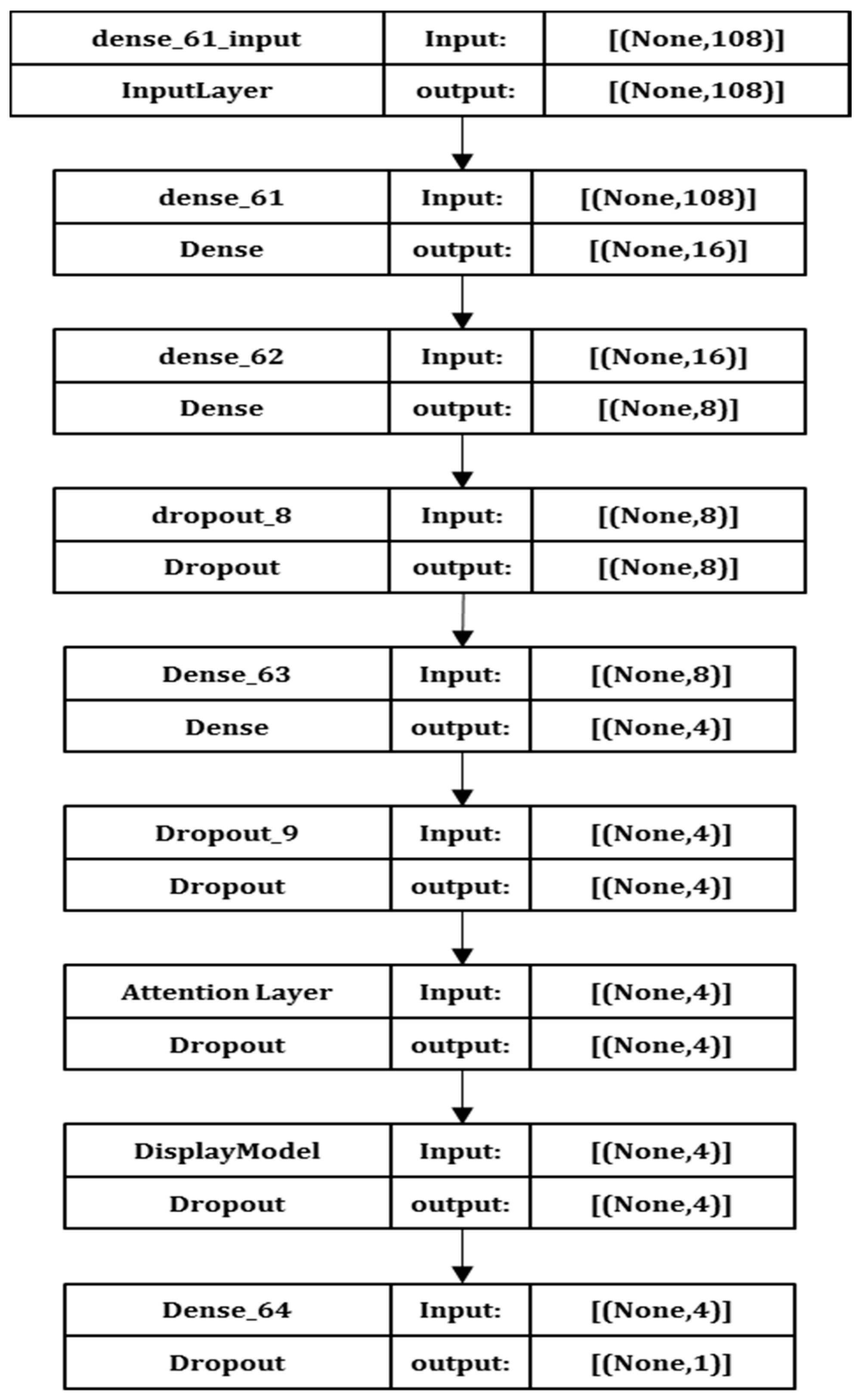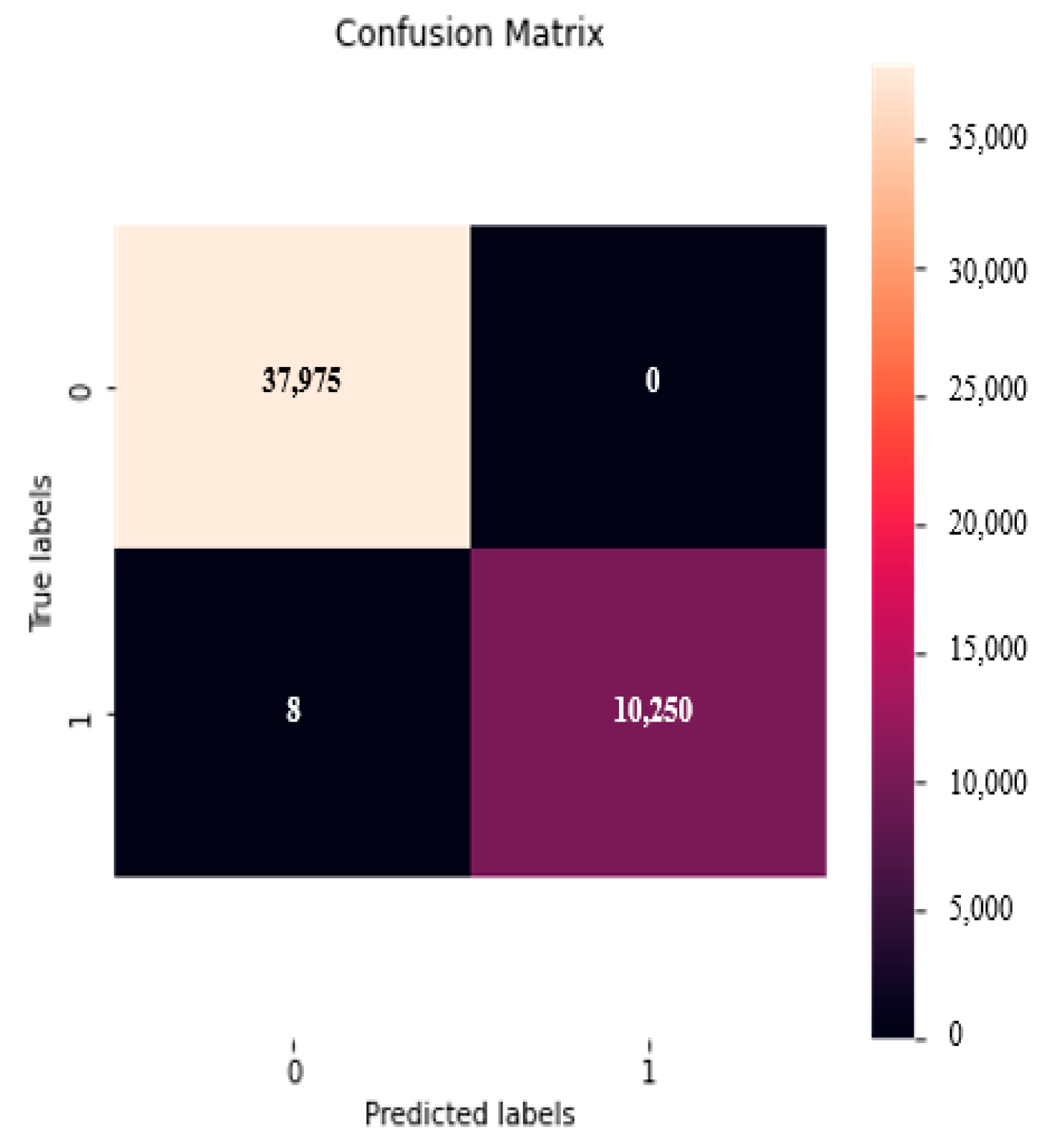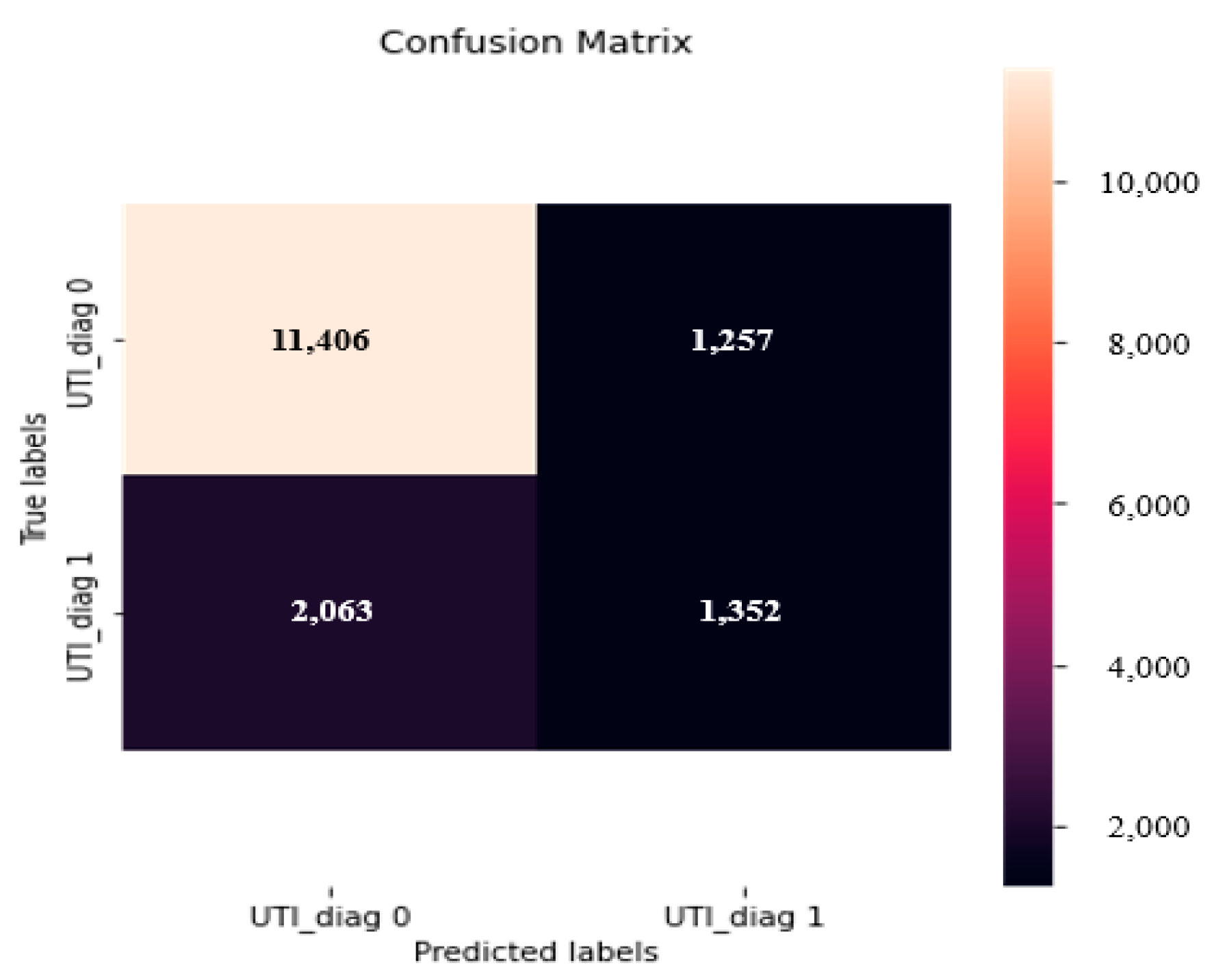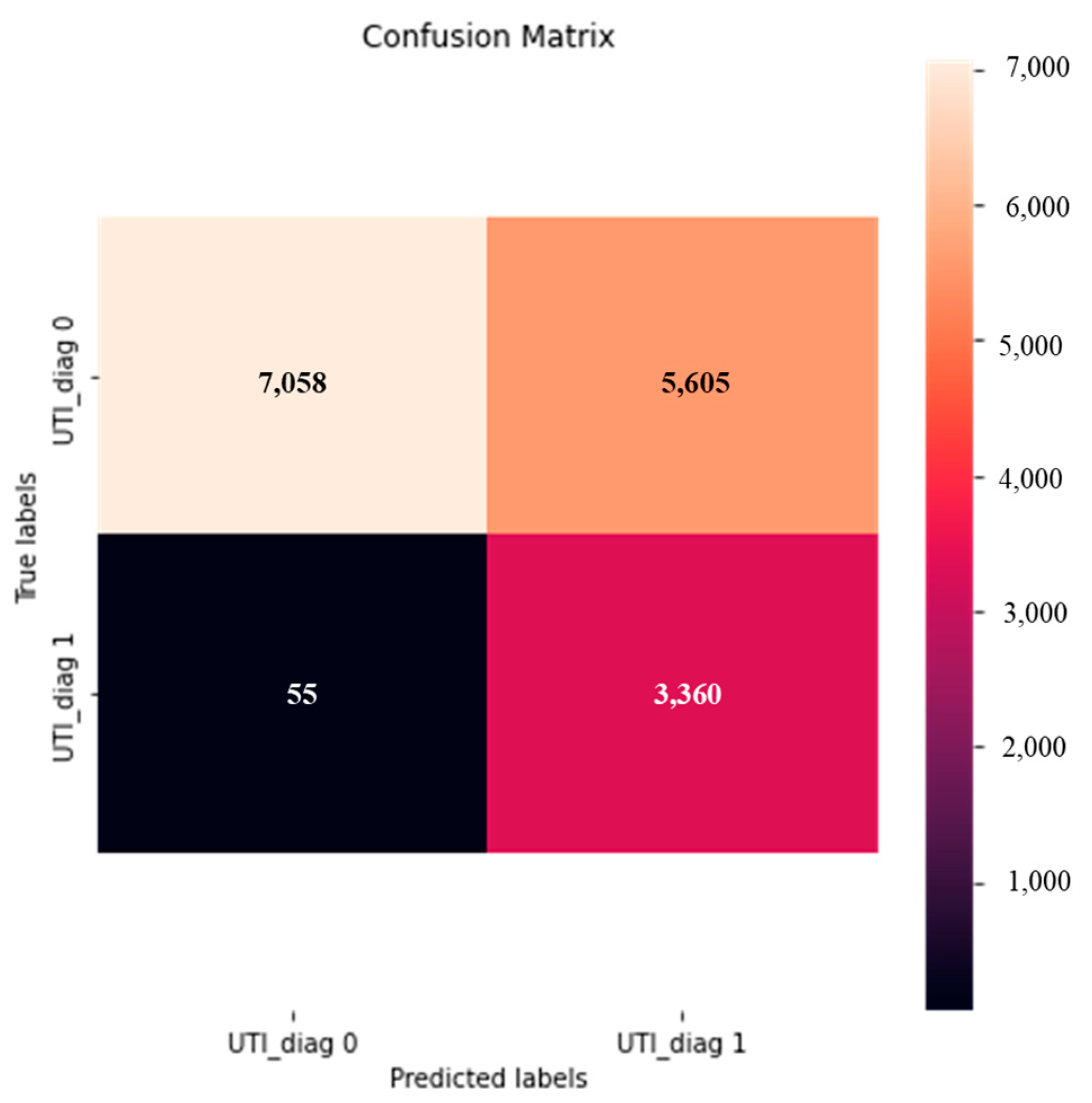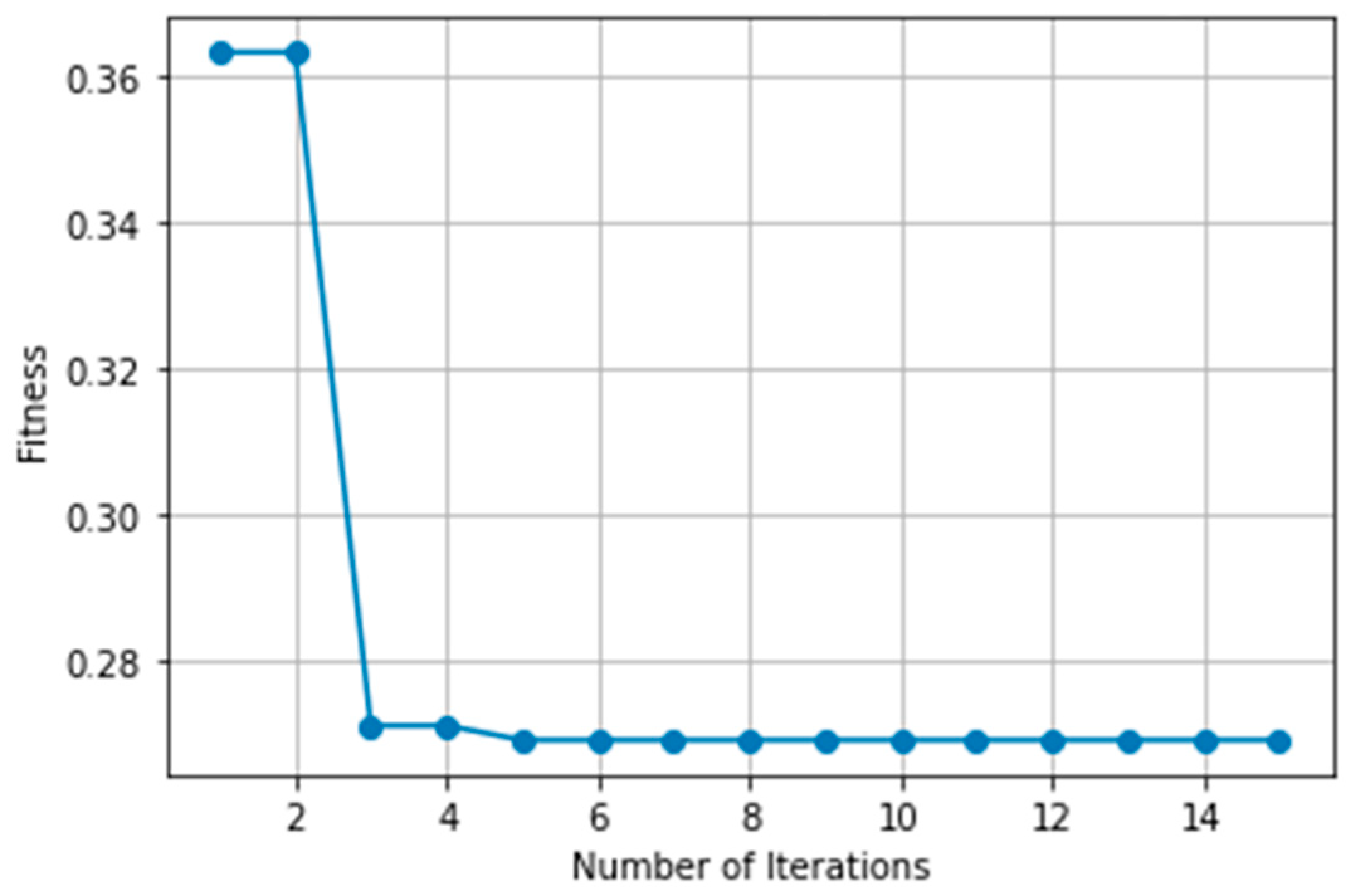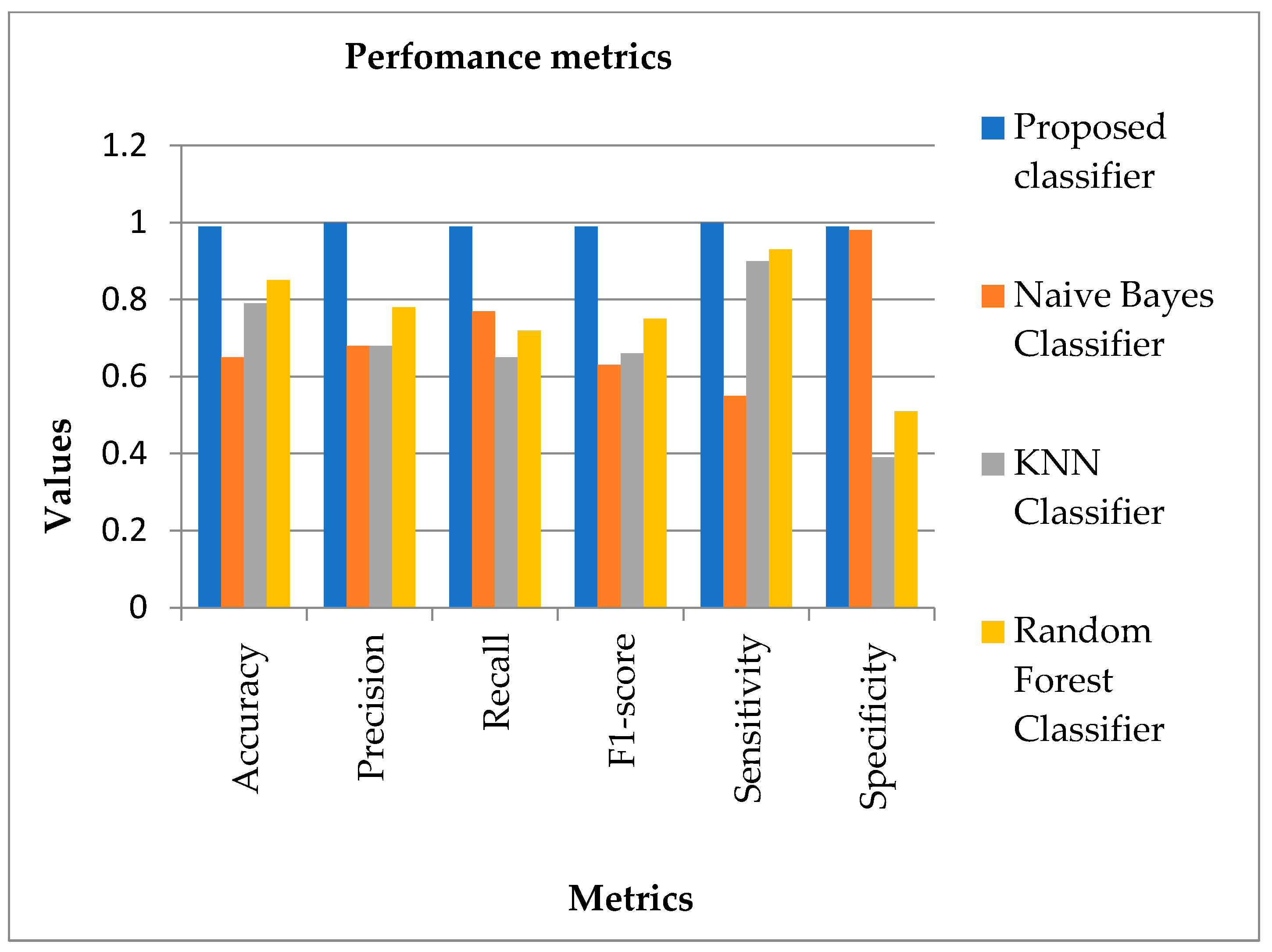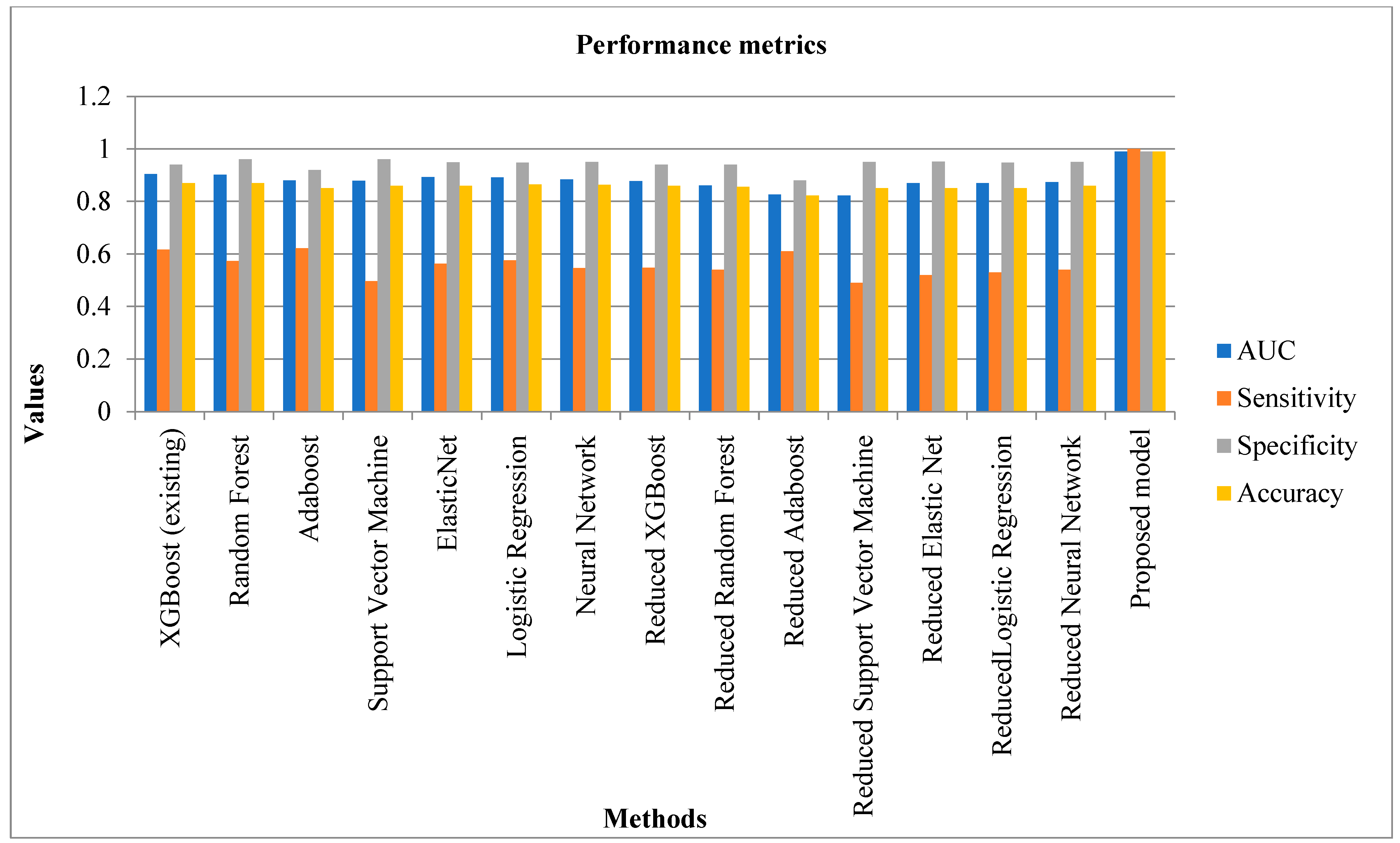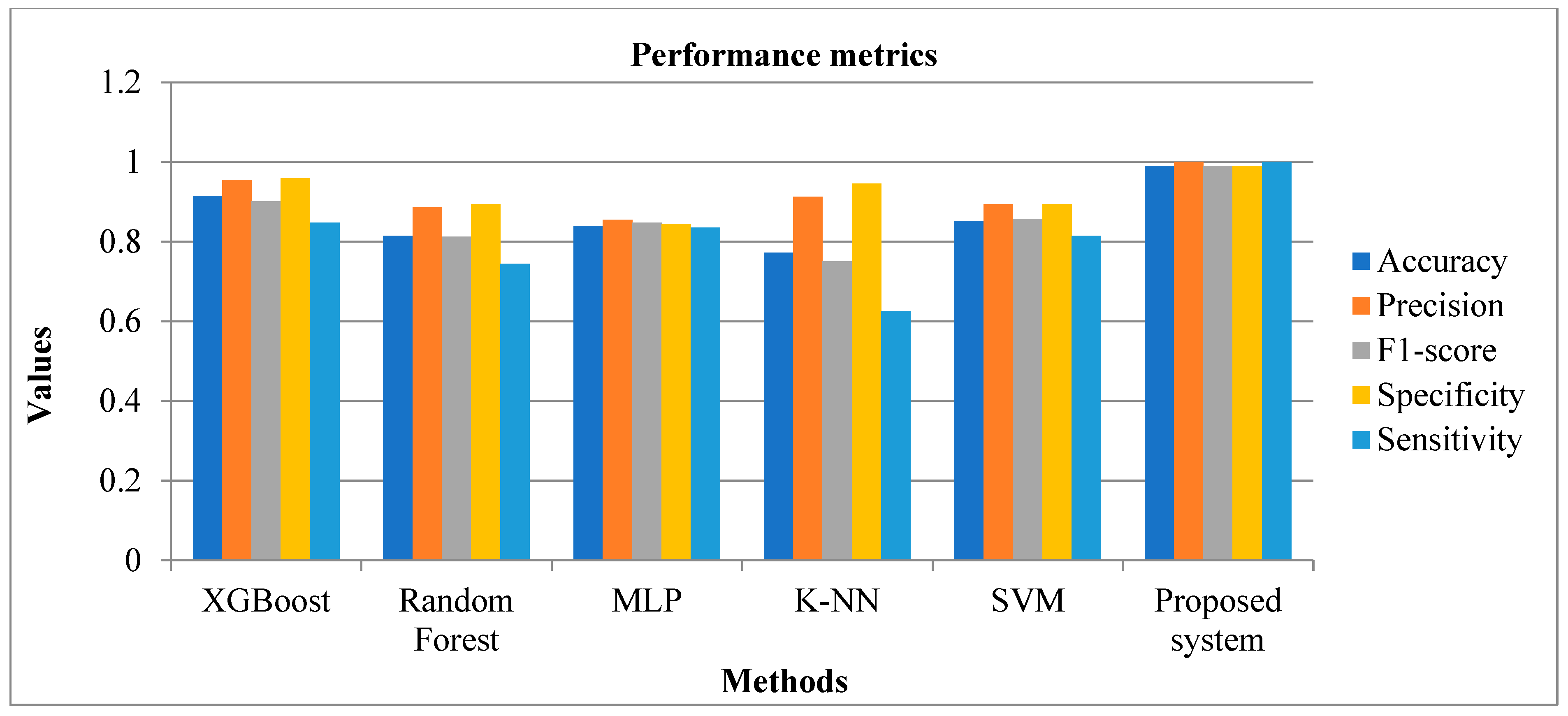1. Introduction
IoT brings more changes to the life of humans and increases the quality of life [
1] by integrating Artificial Intelligent (AI) and cloud computing [
2,
3]. In recent trends, the Internet of Things (IoT) is considered to be the more attractive and revolutionary technology that plays a vital role in various fields such as healthcare, house automation, smart cities [
4,
5], wearable devices and so on. IoT greatly influences the healthcare industry which in turn helps various applications of smart healthcare [
6]. IoT acts as a base for innovative ideas such as Cyber-physical Systems (CpS) [
7], smart cities [
5] and Industry 4.0 [
8]. In the future, fog computing [
9] is used to address the demand for real-time service, which is increasing. Fog computing acted as a platform that provides more storage space, real-time computation power and network services among data centres and end users. By using IoT-Fog computing, many time-sensitive data and services are carried out which include emergency health services and medical diagnosis. Smart healthcare includes various applications such as intelligent patient monitoring, wireless tracking of health and mobile healthcare. Many cities aim to establish the idea of smart city healthcare by means of conventional equipment and devices that integrate the resources of healthcare and smart solutions [
10].
Generally, Machine Learning (ML) models consist of many predictor variables and require less a priori hypothesis in comparison to statistical models [
11]. In the ML-based approach, SVM (Support Vector Machine) and RF (Random Forest) are used to allow fewer assumptions and many difficult relations between predictors. The algorithms are combined with RFE (recursive feature elimination) to provide the optimal predictors for UTI by using the biomarkers present in urine [
12]. To monitor the well-being and health of people who suffered from dementia, IoT has been used, and it also combines ML techniques. The model helps in providing more effective preventive care, which reduces hospitalization [
13].
UTI [
14] is a particular kind of infection that occurs in various parts of the urinary system, which includes the kidneys, urinary bladder and ureters. After kidney transplantation, many people suffer due to UTI [
15]. UTI has been found in both genders irrespective of age [
15]. At the age of 24, one out of three women has at least one symptom of UTI, and while considering the lifetime, nearly half a population is affected [
16]. A survey by the WHO (World Health Organization) confesses that over 1 million people were hospitalized in 2011 due to UTI [
17]. However, quick detection of UTI can prevent people from permanent kidney problems, blood loss and severe pain. Several tests are available to test for UTIs, but home-based UTI testing and detection provide an efficient way for precautionary measures. However, the diagnosis of UTI is still challenging, and current techniques are often prone to more errors. To overcome the issue, several studies have explored the use of ML algorithms to predict UTIs. However, the accuracy of these algorithms is limited due to the improper selection of features. Therefore, the present study aims to develop an ML-based algorithm for UTI prediction in an IoT-Fog environment based on the application of a smart toilet. Additionally, the present study aims to enhance the accuracy rate of UTI prediction, which plays a significant role in patient care.
Further, many IoT devices are available and have an increased capability in acquiring the specific parameters of urine and the determination of UTIs. Especially, IoT includes internet-enabled sensors that have the ability to obtain universal data and transfer the data to a remote location [
18]. Additionally, the devices have used technologies that are easily available and hence can be used in a smart toilet system.
IoT technology provides a considerable revolution in the recent healthcare industry, which helps in monitoring remote patients, smart health services and mobile healthcare. Real-time healthcare services have been boosted by using IoT technology and assisted in the development of communication protocols such as CoAP [
19], MQTT [
20], next-generation IPv6 version [
21] and AMQP [
22] of inter-network. The IoT has enhanced the home-centric environment by extending healthcare services. IoT sensors help in expanding the acquisition of health data, and various technologies such as data mining results in automatic analysis of health conditions without the presence of a concerned doctor. Furthermore, the large use of fog and cloud computing results in providing enhanced services in healthcare applications, which includes time-sensitive data management and analysis. In the modern world, improved IoT and fog-cloud computing [
23] serves many applications in real-time healthcare.
The Firefly Algorithm (FA) [
24] has increased importance in swarm intelligence [
24] and is used in the area of both optimization and engineering. FA and its variants are used to solve various problems from different areas. The ideal behaviour of FA is its flashing feature [
25], which helps in efficient feature selection. Though the basic Firefly Algorithms are comparatively efficient, the outcomes have been changed when it approaches the optima. The success rate of FA depends on the balance that exists between exploitation and exploration. CGFA (Chaotic Gaussian Firefly Algorithm) possesses improved numerical stability and an enhanced convergence rate [
26].
The present study has used MFB-FA (Modified Flashing Behaviour-based Firefly Algorithm) for feature selection by utilizing IoT in a fog environment. Gaussian Chaotic Maps (GCMs) in FA have been used to reveal the optimal fit that helps in exploring chaotic maps. Gauss Map (GM) avoids the trapping of local optima by moving towards the optimal solution and possesses better optimization ability in comparison to swarm intelligent approaches. Hence, the proposed method utilizes GM for attaining improved optimization ability. The present study has used MANN-AM (Modified ANN with Attention Mechanism) for classification. ANN possesses more advantages such as parallel processing, the ability to perform with partial knowledge, storing data within the network and possessing memory distribution and fault tolerance. Similarly, the attention mechanism imitates cognitive attention. MANN-AM performs so that the network has to devote high focus to low but significant data parts. The present study aims to detect UTI by using MFB-FA and MANN-AM based on the following objectives:
To perform feature selection by using MFB-FA (Modified Flashing Behaviour-based Firefly Algorithm) for improvising classification.
To perform classification by using MANN-AM (Modified Artificial Neural Network with an Attention Mechanism) to efficiently prognosticate the existence/absence of UTI.
To evaluate the efficacy of the proposed model with standard-performance metrics for exposing its performance in predicting UTI.
1.1. Novelty
The present study focuses on the relatively new field of research that used bio-inspired and ML algorithms in IoT-Fog environments for predicting UTIs, in which the MFB-FA for feature selection is a revised version of the Firefly Algorithm that utilized chaotic maps for avoiding local optima and assists in improving the global optimization. MANN-AM is a revised version of ANN that utilized an attention mechanism for focusing small and significant data. Therefore, the integration of the novel approaches offers an optimal solution for predicting UTIs by using a smart toilet.
1.2. Contribution
The present research uses an ideal approach that combines both ML and bio-inspired algorithms that highly contributed to the research. MFB-FA utilizes the flashing behaviour depending on the optimal solution of the population. In MFB-FA, each firefly attracts the optimal firefly from the neighbourhood, which depends on a modified attractiveness function. However, MFB-FA possesses limited performance as it becomes trapped in local optima, which may result in a suboptimal feature selection. In order to overcome the limitation, the proposed method utilizes GM for improved optimization ability. By using the GM technique, in each iteration, the position of the fireflies is shifted towards the global optimum. Thereby, GM avoids getting trapped in local optima by moving towards the optimal solution. Moreover, the proposed method swaps the value of the constant absorption coefficient with chaotic maps in MFB-FA. The ability of the chaotic maps evades getting trapped in local optima, introducing randomness into the algorithm, which leads to a highly diverse search of feature space. The combination of GM and chaotic maps in MFB-FA improves the ability of optimization, which results in an exact and efficient selection of features for UTI prediction. MANN-AM utilizes an attention mechanism for scoring and computing the significance of each feature in the prediction of UTI. During classification, the weights of the input features are adjusted based on the scores, which mainly focused on highly informative features for predicting UTI. Moreover, MANN-AM is modified by including additional layers to perform feature fusion for integrating the selected features. The additional layer combines the selected features by using the computed mean and standard deviation that is given as input to the network. Thus, the additional layers assist in capturing the non-linear and complex relationship among the selected features and in UTI predictions. Therefore, MANN-AM assists in the effective and accurate classification of UTI in an IoT-Fog environment.
1.3. Limitation
Though the proposed system has the ability to attain optimal accuracy, it possesses some limitations and challenges. The proposed system extensively depends on the availability and quality of the data and it remains challenging to use high-quality UTI-related features. The implementation of smart toilets with IoT sensors is more challenging and costlier.
Section 2 of this paper deals with the review of the existing literature for feature selection and classification through various ML models. The problem identified from the existing literature has been also discussed.
Section 3 deals with the proposed flow along with the pseudo codes.
Section 4 deals with the dataset description, performance metrics, experimental results, performance analysis and comparative results.
Section 5 deals with the conclusions and future recommendations of the work.
2. Review of Existing Work
In recent times, the application of smart healthcare attains more popularity. Various ML methods have been used in UTI for feature selection and classification. The section has reviewed the conventional models briefly along with the gaps identified from the state-of-the-art works.
IoT in fog environments has been used for quick prediction and diagnosis of urine infection. Initially, multiple sensors have been used to deliver the data and by using XGBoost [
27] ensemble a learning approach, IRF (Infectious Risk Factor) has been calculated at the fog layer. The suggested study [
28] used real-time patient data. The results of accuracy, f-score, sensitivity, precision and specificity have been given as 91.45%, 90.12%, 84.79%, 95.49% and 95.96%, respectively.
For monitoring and prediction of UTIs, the existing paper [
29] has suggested an IoT-inspired framework in a home-centric environment. By using ID (Infection Degree), probabilistic classification [
30] (Bayesian Probabilistic Model) of UTI has been performed in accordance with both infection and non-infection categories. Temporal-Artificial Neural Network (t-ANN) technique, which incorporates IIM (Infection Index Measure), has been used for the detection and prediction of UI. Kohonen Self Organized Mapping Technique [
31] (SOM) has been used for the color visualization of information. Additionally, the development of AI has brought several improvements in the healthcare sector. Thereby, ML and DL methods have also been widely used in detecting several life-threatening diseases such as cervical cancer [
32] and COVID-19 [
33,
34] and also in predicting PCOS [
35].
Diagnosis and monitoring of clinical voiding dysfunction have been assisted in the recommended study [
36]. While urinating, the vibration signals have been detected with the help of an accelerometer and they transformed into MFCC (Mel-Frequency Cepstrum Coefficient) [
37]. The CNN model with pooling and normalization layers with ReLU (Rectified Linear Unit) [
38] has acted as active functional layers. Classification has been done through the Softmax function [
39]. UMAP (Uniform Manifold Approximation and Projection) [
40] dimensionality reduction has been used to predict and analyse uroflowmetry and also helps in void dysfunction diagnosis. The result of accuracy has been found to be 98%.
An integrated platform has been developed and ML models have been used for the analysis of UTI risk and agitation in the suggested study. A huge dataset has been collected, by which a new DL (Deep Learning) model has been evaluated that utilized rational and attention mechanisms. Rational layers have passed through the LSTM layer, and LSTM [
41] has processed the data available in the attention block. For prediction, classifiers have used time steps. In detecting the risk of UTIs and agitation, the outcome values of the suggested model [
42] for precision and recall have been given as 83% and 91%.
Noise, explainability, high dimensionality, large variability and label scarcity are some challenges present in anomaly detection. The efficiency of MP (Matrix Profile) and SOTA has improved by using CMP (Contextual Matrix Profile), which interprets and visualizes the anomalies present in the data of the noisy real world. Graph-based anomaly detection has been used to detect anomalies by using a real-world dataset in healthcare. The recommended method [
43] has possessed an enhanced alert rate, recall and generalizability.
Adaptive DNN (Deep Neural Network) [
44] and supervised parabolic model have trained the model of unlabelled data by utilizing unsupervised techniques. DNN has utilized auto-encoder in terms of learning unlabelled data representation. The trained model has been applied to the labelled data of a smaller set, which helps in the development of a supervised classifier with improved reliability. DL and probabilistic models have been used to analyse UTI risks. The classification of data has been carried out by using SVM [
45] (Support Vector Machine with polynomial kernels and RBF), LR (Logistic Regression) [
46], DT (Decision Tree) [
47] and KNN (K-Nearest Neighbour) [
48]. The suggested ML model [
49] has detected the risk of UTI with a recall value of 85% and precision of 86% with the help of in-home monitoring data. In the existing study, UTI in pregnant women and children less than age 10 has been considered. ML approach has tested three algorithms such as RF [
50], NN [
51] and extreme gradient boosting; at the same time, factoring of independent variables has been executed. A sensitivity of 95% has been achieved by using the suggested model [
52].
Similarly, the existing model [
53] has aimed to develop an ML model that predicts the risk of MDR UTI (Multidrug Resistant Urinary Tract Infection) for patients after hospitalization. Catboost has been used to exhibit the results, and the outcomes are found to be 0.909 as Matthews’s correlation coefficient (MCC), 0.809 as f1-score and 0.717 as accuracy. The predictive model has used an ML algorithm and provided an efficient performance that facilitates UTI. The suggested model [
54] has predicted the RUTI (Recurrent Urinary Tract Infection) that has been associated with vesico-ureteral reflux and with a value of 0.761 as the AUC (Area Under the Curve) in the test set. ML algorithms have been used in the prediction of identifying the incidence of stroke and post-stroke prognosis for immobile stroke patients. The ensemble learning model in the recommended study has provided an efficient performance in the prediction of UTI risk.
A Knowledge Discovery and Data Mining (KDDM) approach using ML methods has been implemented to find the knowledge regarding HA-CAUTI (Hospital-Acquired Catheter-Associated Urinary Tract Infection) from various sources of data and helps in predicting the risk of HA-CAUTI. ML techniques such as DT, LR and SVM have been described in the existing study [
55]. The cutting-edge ML approach has been introduced in electronic health records, which improves secondary utilization. The accuracy of DT, SVM and LR has been found to be 75.87%, 71.50% and 75.83%, respectively.
The test characteristics of ML models have been evaluated to find the results of SBI (Serious Bacterial Infections) in infants and the models have been compared with the recognised clinical prediction rules. The four supervising models such as single-hidden layer neural network, LR, SVM and RF have been developed and validated. The methods have been used for the exact identification of patients without UTI and the recommended model [
56] has attained a sensitivity of 98%. Statistical models have utilized EHR (Electronic Health Record) for identifying the complications of surgery such as UTI, sepsis, bleeding and surgical infections. The elastic-net model has been used to calculate the regression coefficient and to process variable selection. The recommended model [
57] has achieved 83% of sensitivity, 88% of specificity, an area under the curve of 0.93, 52% of positive predictive value and 97% of negative predictive value.
In order to improve predictive accuracy, alternative ML approaches (DL methods and tree-based methods) have been implemented and explored in the recommended study [
58]. To predict the risk of an AE (Adverse Effect) including UTI, the selection operator regulation method, least absolute shrinkage and LR have been applied. For overall AE, the AUC of the prediction model has been found to be 0.7. However, numerous studies have shown AUC values between 0.6 and 0.78 in predicting the complications of UTI after spine surgery. Initially, ML methods have trained both huge records of patients and measurements of antibiotic resistance. The existing study [
59] has provided a way to use ML in decision-making, thereby it helps in the recommendation of antibiotics over UTIs, which has reduced the risk of failure of treatment.
By using Fourier transform infrared, bacterial susceptibility has been examined for first-culture
E. coli colonies for UTI patients. The objective of examining the infrared microscopy in which multivariate analysis has been combined is to cut short the time taken for identifying
E. coli susceptibility to antibiotics and to find the response of bacteria to the optimal choice of antibiotics. The outcomes of the suggested study [
60] have shown that it has been evident to find the optimal choice of antibiotic in which the sensitivity has been found to be 89%, which has followed the first culture. Linear SVM has been used to implement multidimensional classification. When ML classification algorithms have combined with infrared spectroscopy for pattern recognition, it has been considered a powerful tool for determining the susceptibility of
E. coli bacteria, which is a commonly used antibiotic.
For identifying pathogenic microorganisms, MALDI-TOF MS (MALDI-TOF Mass Spectrometry) has been utilised in the diagnosis of infectious diseases. The DL model has been used in analysing the data, and the DL model performance has been compared with conventional and supervised ML algorithms. The suggested study [
61] has illustrated a huge dataset that contains bacterial species in relation to UTIs. By selecting five different species, an accuracy of 85% has been attained.
The ability of infrared spectroscopic microscopy has been evaluated, which includes the multivariate analysis for quick detection of ESBL (extended-spectrum β-lactamase), which produces
Escherichia coli (
E. coli) and has been separated from UTI samples. The outcomes of the suggested study [
62] have shown that it has been evident to find the ESBL-producing bacteria with 99% of sensitivity, 97% of success rate and 94% of specificity for samples that have been tested with less time by succeeding the first culture.
Least Absolute Shrinkage and Selection Operator (LASSO) and LR have been executed to recognise and select the variables for analysis and its results with the potential model. By using the numerical outcomes and clinical criteria, the final model has been selected. Developing ML algorithms for a huge dataset has been made possible, which delivers beneficial tools for counselling patients and in the assessment of surgical risk. The value of AUC has been found to be 0.70 with a Brier score of 0.01. The results of the predictive model for UTI in accordance with specificity and sensitivity have been given as 95% and 97%, respectively [
63].
Problem Identification
Various problems identified from the extensive literature have been discussed as follows:
The collected data from the system have limitations in facilitating large databases and various sources of information and also in voiding dysfunction diagnosis algorithms. The existing algorithm has fewer limitations in accessing the diagnosis information and sometimes has the probability to get diagnostic errors [
36].
By using ML methods, risk factors have generally been neglected by classical statistical models. The data have been extracted on a small scale, and hence the findings possess some limitations in terms of generalizability [
53].
For practical examination, a more precise scoring tool based on the ML model has been needed to improve the outcomes of the model [
11].
3. Proposed Methodology
This study tries to predict the existence or absence of UTI (Urinary Tract Infection) based on ML methods. In spite of the endeavours undertaken by conventional works to accomplish this, they lacked in accordance with classification rates. To attain better prediction performance, this study proposes suitable feature selection and classification algorithms as depicted in
Figure 1. In this case, the UTI dataset is initially loaded. Following this, the data is pre-processed. Typically, the pre-processing of data is crucial prior to its actual usage. It is the process of converting raw data into a clean dataset. Pre-processing is undertaken to check the missing values, noise and other inconsistencies prior to the implementation of the algorithm. After checking the missing values, categorical encoding is performed to convert the categorical data into integer form by which data with the converted category values could be afforded to models for attaining enhanced prediction. As data must be in a suitable format for ML, pre-processing is done. Further, suitable features are selected for making the process accurate. This improvises the prediction ability of algorithms through the selection of critical variables, thereby eliminating irrelevant and redundant features. To achieve this, the study regards MFB-FA (Modified Flashing Behaviour-based Firefly Algorithm). In this process, GCMs (Gaussian Chaotic Maps) are used with FA for selecting suitable features. This is fed into the train and test split with 80% training and 20% testing. Lastly, the classification process is undertaken by MANN-AM (Modified Artificial Neural Network with an Attention Mechanism).
In this case, algorithms, namely, KNN, RF and NB are regarded for internal comparison with the proposed system. The overall performance is assessed with regard to performance metrics.
3.1. Feature Selection MFB-FA (Modified Flashing Behaviour-Based Firefly Algorithm)
FA (Firefly Algorithm) is stimulated by the FF’s (Firefly’s) flashing behaviour. Three assumptions exist in FA as follows:
- (i)
All FFs (Fireflies) are uni-sexual. Each FF gets attracted to each of the other FF.
- (ii)
Attraction is proportional to the brightness of FF. For any 2 FFs, the less bright FF will get attracted by the brighter FF, and the brightness will minimize as the distance enhances.
- (iii)
When no FFs brighter than a specific FF exists, it starts to move in a random manner.
Typically, light intensity (
) is inversely proportional to the distance from the light source. Hence, when the light passes via a medium with the light absorption coefficient of (
), then
differs with the distance (
) as specified in Equation (1):
In Equation (1),
represents the intensity at the source-point. As the computation of
is simpler than
,
could be computed as follows:
Each FF possesses its unique attractiveness (
) and could be claimed as per Equation (3):
Likewise, it could be stated as follows:
In Equation (4), denotes the attraction at as 0.
A FF positioned at the movement (
) gets attracted to another bright FF positioned at (
and is given by Equation (5):
The second term is accredited to attraction, while the third term gets randomization with () and . For numerous practical issues, a constant value (.2) can be used. In this case, denotes the random variable vector retrieved from the Gaussian distribution. On the contrary, chaos exists as a stochastic motion mapped by a deterministic equation. It varies from disorder and irregularity. Chaos possesses a fine internal structure. It comprises three characters: random, regularity and ergodic. The ergodic property could search all the states with its formulae within a specific range. Thus, chaos turns into an efficient approach to avoid getting trapped in local optima with the enhancement in determining global optimum.
The Gaussian function is given by Equation (6):
From Equation (6), it is revealed that the present study initializes the FF population and interchanges the constant absorption coefficient value with the chaotic maps. In this research, GM (also termed mouse-map) is taken into account for moving all the FFs to global optimal in individual iteration. Further, for stabilizing the movement of a FF, a distinct behaviour is proposed for directing the movement of FFs to the global best solution when no ideal solution around it exists.
When a FF is utilized for optimizing the multiple peak function, it could get effortlessly trapped in local minima. This results in less convergence speed. In addition, it is complex for attaining an ideal outcome without using a better search methodology. Chaos is typically a non-linear phenomenon that encompasses features of ergodicity, regularity and randomness as its exquisite internal construction. In this study, MFB-FA was combined with GCM for enhancing the precision and convergence quality of standard FA. Common defects prevailing in FA are discussed below.
The evaluation of the defects of FA in its search process is discussed below.
- (1)
Random Initialization: Though random initialization could assure initial FFs are homogeneously distributed in solution space, the solution quality seems to be uncertain as the FFs seem to go far from the global optimum. When initial FFs seem to be not only homogeneously distributed but also with high quality, it would assist in the betterment of the mass of FFs, thereby preventing the approach of getting prematurely trapped in local optima to a certain extent.
- (2)
The light-absorption coefficient corresponding to exists as the constant value. In this case, the value finds the attraction of all FFs. Generally, might be recommended, and it is convenient. Nevertheless, using fixed values for all issues is irrational. The absorption coefficient has to differ with iterations in the searching space. Thus, in this research, is tuned with the chaotic maps without using a constant value.
In stochastic-searching optimization approaches, the methodologies using chaotic variables rather than random variables are termed chaotic optimization algorithms. In such algorithms, due to ergodicity and non-repeatability of chaos, it could accomplish complete searches at a higher speed than the stochastic searches that rely on probabilities. Thus, in this study, a chaotic map is used for initializing the FF population and tuning the absorption coefficient. The MFB-FA Algorithm 1 is presented below.
| Algorithm 1 MFB-FA: Modified Flashing Behaviour-based Firefly Algorithm |
|
|
|
|
|
|
|
|
|
|
|
3.2. Classification of MANN-AM (Modified Artificial Neural Network with Attention Mechanism)
ANN (Artificial Neural Network) is a term that is used to describe a biologically stimulated sub-area of AI (Artificial Intelligence) and is modelled after a succeeding brain. Usually, ANN is a computational network relying on biological networks that build the structure of the human brain. Identical to the human brain, it possesses neurons interconnected with one another. ANNs also comprise neurons that are associated with one another in several network layers. Such neurons are termed nodes. The main merits of utilizing ANN involve its parallel processing ability, storing data within the network and the ability to function with partial knowledge. It also possesses memory distribution. It is also fault tolerant. Concurrently, an attention mechanism exists with the idea of permitting a decoder to use relevant input sequences flexibly through weighted integration of all encoded inputs, with related vectors being credited with maximum weights. In ANNs, attention is meant for imitating cognitive attention. The effect improvises certain input data parts while alleviating other parts. The motivation for using MANN-AM prevails in the fact that the network has to devote a high focus to less, but significant, data parts. The overall model of MANN-AM is shown in
Figure 2, wherein the model performs layer-wise learning.
The proposed model is designed for predicting the absence or existence of UTI. This is undertaken by normalization (), Euclidean distance (), Nearest Neighbour () and Sigmoid activation-function ().
- (i)
Normalization
Normalization ensures that both negative and positive values considered as input for the subsequent layer exist. This makes learning flexible, and the network considers all the input features to a certain extent while learning. It is given by Equation (7):
In Equation (7), indicates the data, represents the minimum values in each of the columns and represents the maximum values in each of the columns.
- (ii)
Euclidean distance
The Euclidean distance computes the distance amongst the vectors with two real values. It is given by Equation (8):
In Equation (8), represents the distance, indicates the length and and denote the Euclidean vectors.
- (iii)
Nearest-Neighbour
The Nearest Neighbour is given by Equation (9):
In Equation (9), indicates the membership-values in the class, represents the neighbour residue of (), indicates the present residue, which is allocated to the membership values, denotes the Nearest Neighbour and represents the distance amongst residues.
Rather than considering all high and low weights, the above equation is utilized for picking only the least Nearest Neighbour that relies on the value, which affords outcomes effectively in comparison to a conventional classifier.
- (iv)
Sigmoid-Activation Function
The sigmoid-activation function is given by Equation (10):
In Equation (10), indicates the exponential function that is utilized for computing the activation function comprising a small real value ranging from −1 to 1. The algorithm corresponding to MANN-AM is shown in Algorithm 2.
| Algorithm 2 MANN-AM (Modified Artificial Neural Network with Attention Mechanism) |
|
|
The RF algorithm is shown in Algorithm 3.
| Algorithm 3 Random Forest |
|
|
The overall algorithm of K-NN is given in Algorithm 4.
| Algorithm 4 K-Nearest Neighbour |
|
|
|
|
|
|
|
|
The NB algorithm is based on the conditional probability principle as per Bayes theorem. The following steps are to be followed (as exposed in Algorithm 5).
| Algorithm 5 Naive Bayes classifier |
(in %)
|
|
| and |
|
|
|
|
|
|
|
4. Results and Discussion
The results that have been obtained by the implementation of this work are included in this section, with its dataset description, standard-performance metrics, experimental results, performance and comparative analysis.
4.1. Dataset Description
The dataset consists of 80,387 attributes and 219 rows, and some of them are given below:
Age: Shows the patient’s age.
Sex: Represents the patient’s gender.
Diabetes: The presence of diabetes is shown by using a binary output.
Hypertension: This shows the existence of hypertension by using a binary variable.
UTI history: This shows the presence of UTI or not.
Fever: A binary variable shows whether the patient has a fever or not.
Dysuria: A binary output indicates whether the patient has any discomfort or pain during urination.
Urgency: A binary output indicates whether the patient feels the need to urinate urgently or not.
Frequency: A binary output that denotes whether the frequency of the urination is increased over normal times.
Hematuria: A binary output that denotes whether the patient has blood in their urine or not.
WBC_count: This represents the count of the white blood cells, which is measured in cells per microliter.
Bacteria_count: This represents the bacteria count present in the urine of the patient, which is measured in colony-forming units per milliliter.
Nitrite: A binary output that denotes the existence of nitrite content in a patient’s urine.
Leukocyte: A binary output that denotes the existence of leukocytes in a patient’s urine.
Diagnosis: A binary output that indicates whether the patient has UTI or not.
The above-mentioned attributes are some of the attributes that help in training and testing the ML algorithms in predicting the UTIs by using the medical history and symptoms.
Pre-processing has been carried out to identify and handle the missing values. Categorical data have been encoded with the values 0 and 1 and check for the missing values.
4.2. Performance Metrics
The performance metrics have become a part of each ML. Metrics, namely, precision, accuracy, f1-score, specificity, recall and sensitivity are utilized to analyse the classification models.
4.3. Experimental Results
The experimental results attained when using the proposed method MANN-AM have been shown in
Figure 3, in which the red color denotes 0 and the blue color denotes 1. The green line denotes the target value that classifies the target data.
Figure 4 shows the feature importance of the proposed model based on the number of iterations. From
Figure 4, it is clearly found that during the initial iteration, the proposed model has taken a long time for feature selection. After several iterations, the proposed model has learned to select features more efficiently. Selecting the appropriate features is an important step for predicting UTI. Based on the selected features, the proposed model performs a classification by using MANN-AM, which efficiently prognosticates the existence/absence of UTI.
4.4. Performance Analysis
Performance analysis of the proposed study that has used the proposed MANN-AM classifier, KNN, NB and RF has been discussed; it gives detailed information and helps in a better understanding of the proposed model.
Figure 5 shows the AUC curve for the proposed MANN-AM classifier, Naive Bayes, K-Nearest Neighbour and Random Forest, where TPR refers to True Positive Rate and FPR refers to False Positive Rate.
AUC shows a collective measure of performance across all possible classifications. From
Figure 5, it is observed that the value of AUC for the proposed MANN-AM classifier has been given as 0.99961, which is closer to 1. For the KNN classifier, the value of AUC has been given as 0.64831. For the Naive Bayes classifier, the value of AUC has been given as 0.77063. For the Random Forest classifier, the value of AUC has been given as 0.72489. Hence, it is revealed that the proposed model has better efficiency in accordance with classification.
The confusion matrix of the proposed system, KNN, NB and RF, is shown in
Figure 6,
Figure 7,
Figure 8 and
Figure 9, respectively. From
Figure 6, it is clear that the proposed method has a majority of correct estimates of UTI, which is represented in the diagonal portion (0, 0 and 1, 1). Though it estimates a few wrong predictions, which are represented in black color, when comparing, the proposed method has more accurate estimates than the wrong ones. Hence, the proposed method is more efficient. From
Figure 7, it is clear that the KNN classifier has 11,406 true positives, 1257 true negatives, 2063 false negatives and 1352 false positives. The performance analysis of the Naive Bayes classifier has been shown in
Figure 10 by using the AUC curve.
From
Figure 8, it is clear that the Naive Bayes classifier has a majority of correct estimates of UTI, which are 7058 true positives, 5605 true negatives, 55 false negatives and 3360 false positives. From
Figure 9, it is clear that the Random Forest classifier has 11,825 true positives, 838 true negatives, 1653 false negatives and 1762 false positives.
The Modified Flashing Behaviour-based Firefly Algorithm using a Gaussian Map has been shown in
Figure 10.
During the initial iterations, the proposed model attained a higher fitness value. When the number of iterations increased, the proposed model learned to select features more efficiently and steadily, which is shown in
Figure 10.
4.5. Performance Analysis of Classifiers
The proposed model Modified ANN-AM has been compared internally with KNN, Naive Bayes and Random Forest classifiers to show that the proposed model has improved efficiency among other classifiers. The performance analysis of Modified ANN-AM, NB, KNN and RF is shown in
Table 1 and
Figure 11.
The proposed model has been analysed by using six performance metrics, and the values are given in
Table 1. The proposed model has an accuracy of 0.99, recall of 0.99, precision of 1, f1-score of 0.99, specificity of 0.99 and sensitivity of 1. The Naive Bayes has an accuracy of 0.65, recall of 0.77, precision of 0.68, F1-score of 0.63, specificity of 0.98 and sensitivity of 0.55. The KNN classifier has an accuracy of 0.79, recall of 0.65, precision of 0.68, f1-score of 0.66, specificity of 0.39 and sensitivity of 0.9. The Random Forest classifier has an accuracy of 0.85, recall of 0.72, precision of 0.78, f1-score of 0.75, specificity of 0.51 and sensitivity of 0.93.
From
Table 1 and
Figure 11, it is clear that the proposed model of Modified ANN with AM is more efficient and has better values in all performance metrics. Hence, it can be concluded that the proposed model shows an enhanced performance in UTI detection.
Table 2 shows the feature ranking by Firefly Algorithm, in which chloride refers to the chloride content that exists in urine, ua_ketones refers to the ketones level in urine, ua_clarity refers to the clarity level of the urine, ua-color refers to the color of the urine, ua-glucose refers to the glucose level in urine, Temp_Mean refers to the body temperature of the patient and the fever attribute shows whether the patient has a fever or not.
By using the proposed method, the feature ranking for chloride, HR_Min and chloride again are the three most important features for predicting UTI, and the feature importance scores are given to be 0.089883, 0.074717 and 0.072249, respectively. The other features such as ua_ketones, ua_clarity, ID, ua_color, fever, lang, abd_distended2, ua_glucose, Temp_Mean, HR_First and UCX_abnormal have lower feature importance scores, which indicates that they have a relatively lower contribution in the prediction of UTI. In
Table 2, it is observed that chloride has a higher ranking of 0.089883.
4.6. Comparative Analysis
The proposed model has been compared with two traditional studies and the respective results have been discussed. The dataset of the proposed study has used an IoT-based fog environment, hence the existing studies which have similar types of datasets have been considered in the comparative analysis.
Table 3 shows the comparative analysis of various models.
For extensive analysis, the proposed model has been compared with the existing study [
64], which has a dataset similar to the proposed study and used various classification models. In the existing methods, XGBoost has a higher accuracy of 0.9 compared to other models. In
Table 3 and
Figure 12 it is revealed that the proposed model possesses ideal values in every performance metric and has attained the highest accuracy of 0.99.
The comparative analysis of performance metrics of the proposed model with the existing study [
64] is shown in
Figure 12.
Table 4 shows the comparative analysis of various models in the existing study [
32].
For broad analysis, the comparative analysis has been done with the existing study [
32], which has a dataset similar to the proposed study and used various classification models.
The comparative analysis of the performance metrics of the proposed model has been shown in
Figure 13. In the existing methods, XGBoost has a higher accuracy of 0.9145 compared to other models. In
Table 4 and
Figure 13, it is revealed that the proposed system has better values in every performance metric and has attained the highest accuracy of 0.99. The proposed MANN-AM classifier has greater potential in focusing on small and significant data. The MFB-FA model for feature selection has helped in attaining a global optimum. Hence, from the experimental results, performance analysis, internal analysis and comparative analysis, it is revealed that the proposed study has better efficacy in every performance metric in detecting UTI.
